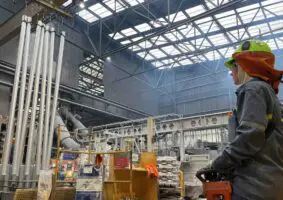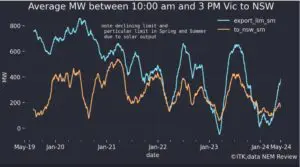In this note I apply elementary statistical analysis to squeeze historic wholesale price data to see if they will offer a confession on why Victoria’s demand-weighted average wholesale electricity market price rose by 46% in 2016, compared to 2015.
A common technique I apply in analysing historic wholesale price data is to split the average annual wholesale price into a component that measures the average of the prices in the 72 most expensive half-hourly Settlement Periods in the year, and a second component which measures the average price in the remaining 99.6% of Settlement Periods in the year.
This allows me to see how average annual prices have been affected by the prices in the few extremely high-priced Settlement Periods in the year. The result of this dissection is shown in the table below.
| Victoria ($/MWh) | 2015 | 2016 |
| Demand-weighted average price | $36 | $52 |
| Demand-weighted average price excluding top 72 settlement periods | $35 | $49 |
| Demand-weighted average price top 72 settlement periods | $268 | $714 |
The figure below extends the comparison of the 2015 and 2016 wholesale prices in a histogram of all the half-hourly settlement prices in each of these two years. The X-axis shows the price bands that form the buckets of the histogram, and the Y-axis measures the number of Settlement Periods whose prices fall into each bucket.

It is striking in this figure that in 2016 there were much fewer instances when prices ranged between $35 and $45/MWh, and much more instances when prices were above $55/MWh. Effectively there was a step change in the distribution of prices in 2016, compared to 2015, when Settlement Period prices were above $30/MWh. Why?
Well, what happened in 2016 is that gas prices, as measured by the average quarterly prices in the Victoria Gas Market, rose 69% from $4.12 to $6.69 per GJ. The price of gas-fired generation that sets the wholesale market price in South Australia almost all of the time, in Queensland often and in New South Wales and Victoria sometimes, inevitably took a big leap up to reflect these higher gas prices.
Since the NEM is an interconnected electricity market that has unconstrained interconnectors for the vast majority of the Settlement Periods, the prices in one regional market flow through into the next. And thus we see how higher gas prices have flowed through into higher wholesale electricity prices.
I have replicated this analysis in the other regions of the National Electricity Market and see the same thing, although there are additional effects related to the exercise of market power in the highly concentrated Queensland and South Australia markets.
So what role has renewables played then? Well if you live in South Australia, on a sufficiently sunny and windy day it will be renewable generation that is producing almost all the electricity. Gas generators will often offer to pay the market for the privilege of continuing to produce electricity so that they continue to be dispatched and thereby avoid the higher losses they would otherwise incur if they were to to shut down and later have to restart their plant when the renewable production diminishes or demand rises. Amazingly these negative prices occurred for 196 hours in 2016.
Renewable generation in SA has depressed wholesale prices compared to what they otherwise would have been, just as has occurred in various European countries and states in the United States where renewable capacity has expanded to become a significant proportion of the generation mix.
This is not to diminish the concern that high levels of renewable penetration will require a different mix of generation, storage and price-responsive demand from the one we have now. Of course there is nothing new here, this has long been known. It may or may not mean a more expensive power system in future than the one we have had historically. In view of the staggering advances in technology I incline increasingly to the view that it will be a much cheaper power system in future than the one we have had historically, but I’ll leave discussion of that for another time
Looking at what we see in the markets today, this analysis has shown that the principal reason for the very large increase in wholesale electricity prices is higher gas prices.
Lets hope those LNG producers in Queensland are delivering lots of taxable profits and royalty income for the benefit of Australia’s burghers, farms, shops and industrial electricity users who now bear unpleasant side effects of this new LNG industry, in their electricity bills.
Bruce Mountain is the Director of Carbon and Energy Markets and co-founder of retail market data provider, MarkIntell










